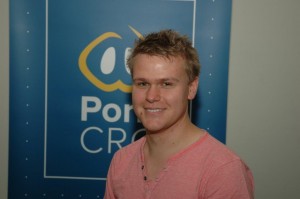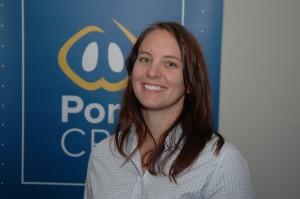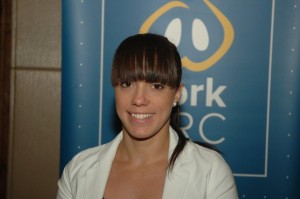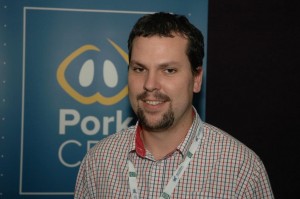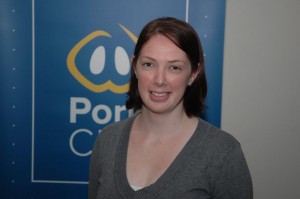Aim
– To retain personnel that Pork CRC has trained at the honours & postgraduate level, by sponsoring their placement in a commercial pork production organisation within the Australian pork industry in a structured and enhanced development program.
– To attract and stimulate those university students showing an interest in joining the pork industry into the production side of the business as a career, while continuing their development and understanding of how research and technology will enhance industry competitiveness and success
– To expose those graduates wanting a long term research or technical support role in the industry, to the commercial aspects of pork production and hence enhance their future contributions and value to pork businesses in their future roles.
For further information, click here
Application Form
Recipients
Fan Liu – Rivalea
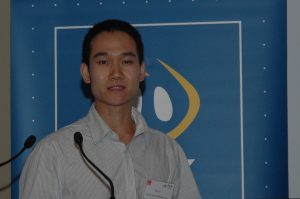
Vanessa Morris – Chris Richards Group
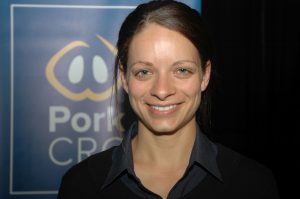
Anthony Martyniuk – APFG – 2015
Claire Payne – Craig Mostyn Group – Replaced Amy Suckling
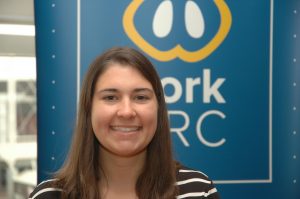
Amy Suckling – Craig Mostyn Group – 2015
Given her name, it is not surprising that Amy Suckling ended up working with pigs. After spending her university work experience at an intensive pig breeding unit near Perth WA, she knew that she wanted to continue to learn about pig production and work in the industry one day. When seeking out an honours project, she naturally chose one involving pigs and after making it into the top 10 at the Intercollegiate Meat Judging Competition, an opportunity arose to explore a meat quality issue at the Linley Valley Pork abattoir in Western Australia. A project was established and conducted with guidance from Professor John Pluske and Dr Cameron Jose from Murdoch University and supported under Pork CRC’s Program 3.
Amy graduated in 2012 with a Bachelor of Animal Science (Hons) and a Bachelor of Science in Molecular Biology and was offered an opportunity to work with Craig Mostyn Group at the Linley Valley Pork abattoir in a scientific capacity. Craig Mostyn Group is an Australian owned diversified food and agribusiness company that produces fresh pork, seafood, protein meal, tallow, cooking oils and fruit products, servicing domestic and export markets. A Pork CRC industry placement program scholarship was sought to support the new graduate in her role with Craig Mostyn Group. The multifaceted role, which involves working on-site at the abattoir and on-farm, aims to develop a structured research program for the company’s meat and livestock division. The focus of projects is largely concentrated on improvements in meat quality and the development of niche markets, but other areas include abattoir and on-farm welfare, pig health and pig production. Amy is grateful for the extensive support and guidance she receives from Dr Megan Trezona of the Department of Agriculture and Food Western Australia, as well as support from her colleagues at Linley Valley Pork and mentors Dr Bruce Mullan, Professor John Pluske and Dr Cameron Jose.
Tracy Muller – CHM – 2013
Tracy completed a Bachelor of Applied Science (Hons) and has a Masters in Biometeorology from the University of Queensland. During this time she spent most of her time in Rockhampton working alongside the CSIRO. Her research was based primarily on the health and welfare of livestock when transported by sea and she investigated the effects of atmospheric ammonia and other microclimatic conditions.
Most recently, Tracy spent time in Canada working at a pig research facility in Saskatoon, Saskatchewan, known as the Prairie Swine centre. She worked with the ethology team, investigating sow housing and welfare. They spent a lot of time completing research on removal of stalls in gestational housing and associated lameness. While there she was fortunate to meet Pork CRC CEO, Dr Roger Campbell and soon became employed by CHM Alliance Pty Ltd., in conjunction with the Pork CRC industry placement program.
After returning to Australia in January 2013, she commenced employment with Professor Robert van Barneveld and the team at the CHM Westbrook Research Facility. The CHM Alliance includes Cameron Pastoral Company, DA Hall and Co, McLean Farms, Sunpork Commercial Piggeries, PIC Australia and PIC New Zealand. The group also owns Swickers Kingaroy Bacon Factory and Sunpork Fresh Foods. Within CHM Alliance they offer members services in relation to science and technology, benchmarking, quality assurance and training. The group currently represents Australia’s second largest pork producer and offers a highly dynamic work environment.
In her role as Research Associate she assists with the coordination and delivery of commercial and public sector projects contracted to CHM Alliance. She also takes a lead role within the benchmarking program, with responsibility for weekly data compilation and trend analysis.
After becoming heavily involved in sow research, the team is now investigating a series of physical and nutritional strategies in gilts and sows as a means of improving longevity and reducing the incidence of culling due to lameness. Her most recent experiment involved developing methodologies for rapidly assessing sow lameness, using veterinary thermography. Thermography appears to be a useful tool for targeting treatment in those sows showing signs of lameness, as it allows identification of the potential primary cause and then can provide appropriate care and treatment.
David Lines – APFG, Research and Adoption Manager – 2012
Dr David Lines, along with Rebecca Athorn, was one of the first two Pork CRC Industry Placement Program appointments. While Rebecca is with Rivalea Australia, David is with Australian Pork Farms Group (APFG).
A Pork CRC Essential Participant, APFG, now part of the CHM Alliance, is a multi-site company, integrated from feed processing, breeding/finishing and processing of pigs. David commenced employment with APFG in December 2011 in conjunction with the Pork CRC’s industry placement program, initially as technical officer and now as Research and Adoption Manager.
Industry roles – He is a representative on the Pork CRC’s sow housing advisory group, which provides industry feedback on R&D in oestrus stimulation during lactation, low confinement housing options for farrowing and lactating sows, as well as mixing strategies for group housed gestating sows. David is also on the Pork CRC’s expert advisory group for Program One, which investigates confinement-free sow and piglet management as well as APL Specialist Group Three which investigates nutrition, health and physiology
APFG team – The APFG Production team, which includes David as Manager, Technical Officer Tracy Kennett and Anthony Martyniuk, collaborates with researchers from the University of Adelaide and SARDI. The APFG team has worked on projects such as oestrus stimulation during lactation, testing of feed additives to improve performance in weaners as well as lactating primiparous (i.e. from farrowing of a sow’s 1st litter until farrowing of the 2nd litter) sows to improve subsequent reproductive performance, gestation feeding strategies for sows to improve litter size and piglet birth weights, as well as low confinement housing options for farrowing and lactating sows.
Farm focus – David’s role at APFG is to not only to co-ordinate external and internal sow trials within the group’s commercial herds, but, along with key Production Managers, to help implement these findings within farms. His recent focus has been new breeding management programs and, in conjunction with veterinarians, he has implemented new health management protocols.
David’s current interests involve improving the longevity and reproductive wastage of sows, as well as confinement free farrowing and lactation accommodation, with various projects investigating these topics. David and his team are grateful for the support given by the Pork CRC, APL and SA’s Pig Industry Advisory Group for past and current projects.
Beefed up – David graduated from the Beef CRC post-graduate program, where he investigated the genetic and phenotypic consequences of selection for residual feed intake in ruminants.
Residual feed intake is an animal’s feed intake that is under or above what would be expected based on weight and performance. As such, it has been used as a predictor of variation in an animal’s maintenance requirements. David’s work showed that selection for reduced maintenance requirements in an animal may be impossible with the methods currently available. Instead, it appears that selection for a reduction in residual feed intake reduces that animal’s capacity to deposit fat, with this reduction in fat deposition having negative carcass specification and reproductive consequences.
Well qualified – David has a Bachelor of Agricultural Science and Bachelor of Science (Hons) from The University of Adelaide and a PhD in Animal and Veterinary Science from The University of Adelaide, in conjunction with The University of New England, where he spent most of his time during his PhD, which was in ruminant growth physiology.
Rebecca Athorn – Rivalea – 2012
In 2006, while completing a Bachelor of Applied Science specialising in Animal Studies at University of Queensland, Rebecca Athorn did work experience at the University’s Gatton on-campus piggery, where she had her first real experience working with pigs under commercial conditions. She has never looked back and has continued to work with and research pigs. In 2007, Rebecca completed an Honours project on ractopamine supplementation in finisher diets and its effect on production, carcass characteristics and profitability. However, her real interests were in reproduction and after completing her Honours degree she moved from Queensland to South Australia to start a Pork CRC supported PhD project studying the effect of increased feeding levels during early gestation on local versus systemic progesterone and its effect on embryo survival and litter size in gilts, supervised by Dr Pieter Langendijk from SARDI.
Rebecca’s thesis proved that local progesterone supply to the uterus plays an important role in embryo survival, in conjunction with that of systemic progesterone. Feeding level also has a differential effect on progesterone concentrations in local blood circulation, compared to systemic circulation, with benefits of a high feeding level only discernable at a local level. From an industry perspective, this means gilts can be fed at feed levels that still promote growth and development leading to increased longevity, without any detrimental effects on embryo survival and possibly positive effects on pregnancy rates, which further helps increase pigs born per sow per year.
Towards the end of her PhD, Rebecca accepted the opportunity to join the Research and Innovation Division of Rivalea Australia as a Research Scientist as part of Pork CRC’s Industry Placement Program. As a member of the Rivalea R&I team, she conducts and manages internal and industry funded collaborative projects into the management of lactational oestrus, nutrition of sows during gestation and lactation, pre-weaning survival, sow and piglet welfare, gilt development and sow longevity.She is also a representative on Pork CRC’s sow housing advisory group, which provides industry feedback on R&D in oestrus stimulation during lactation, low confinement housing options for farrowing and lactating sows and mixing strategies for group housed gestating sows.
Rebecca has also enjoyed five months in Canada (under Pork CRC’s Industry Placement Program), assessing the genomic aspects of lactational oestrus in primiparous sows with Professor George Foxcroft on a collaborative study between SARDI, Pork CRC and University of Alberta.




